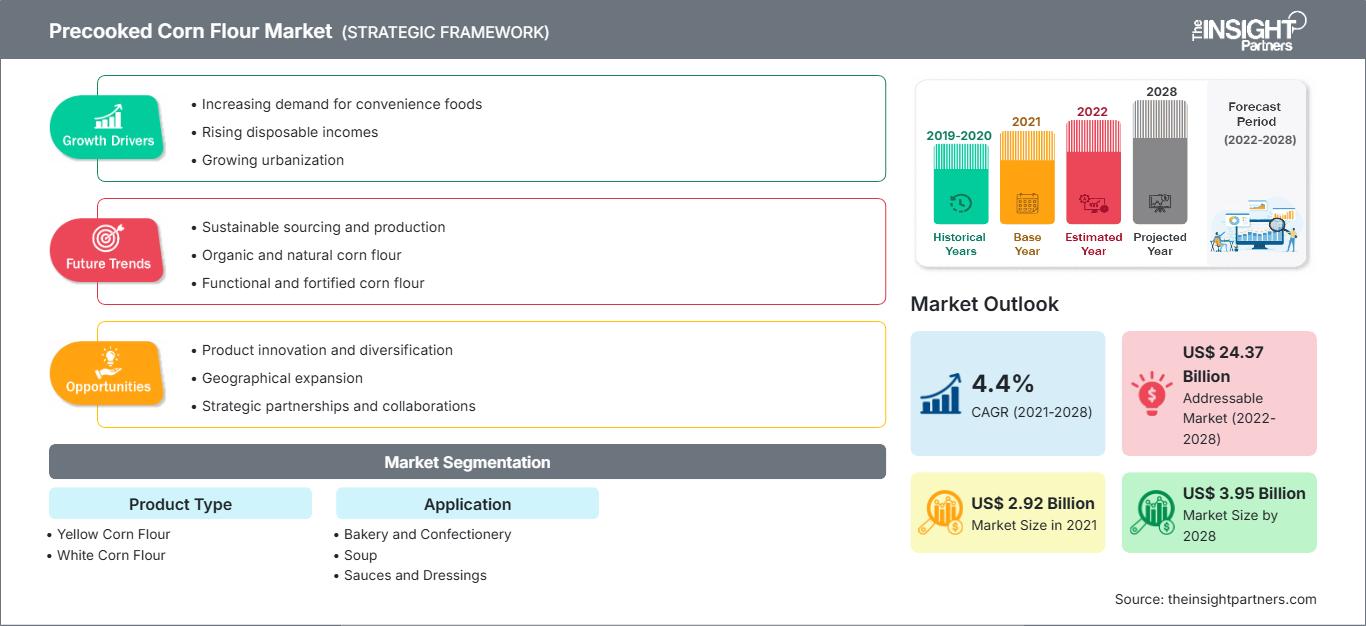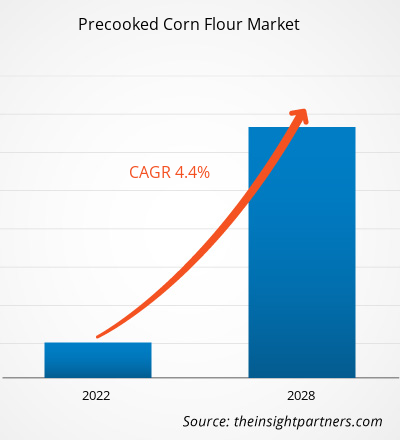Il mercato della farina di mais precotta è stato valutato a 2.918,78 milioni di dollari nel 2021 e si prevede che raggiungerà i 3.953,67 milioni di dollari entro il 2028; si prevede una crescita a un CAGR del 4,4% dal 2021 al 2028.
La farina di mais precotta è senza glutine ed è un ingrediente essenziale per preparare tortillas, tamales e altri piatti messicani. L'adozione della cucina messicana in tutto il mondo sta aumentando il consumo di farina di mais precotta.
Nel 2020, l'area Asia-Pacifico ha dominato il mercato globale della farina di mais precotta e si prevede che manterrà tale posizione dominante durante il periodo di previsione. La crescente consapevolezza dei benefici per la salute e il ricco profilo nutrizionale offerto dai prodotti preparati con farina di mais precotta stanno trainando la crescita del mercato della farina di mais precotta in tutta la regione. Inoltre, l'aumento del reddito disponibile e l'aumento dell'utilizzo della farina di mais precotta hanno portato a una crescente domanda di questo prodotto. Inoltre, la crescente adozione e consumo di cibo messicano in paesi come Australia e India sta alimentando la domanda di farina di mais precotta.
Personalizza questo rapporto in base alle tue esigenze
Potrai personalizzare gratuitamente qualsiasi rapporto, comprese parti di questo rapporto, o analisi a livello di paese, pacchetto dati Excel, oltre a usufruire di grandi offerte e sconti per start-up e università
Mercato della farina di mais precotta: Approfondimenti strategici

- Ottieni le principali tendenze chiave del mercato di questo rapporto.Questo campione GRATUITO includerà l'analisi dei dati, che vanno dalle tendenze di mercato alle stime e alle previsioni.
Potrai personalizzare gratuitamente qualsiasi rapporto, comprese parti di questo rapporto, o analisi a livello di paese, pacchetto dati Excel, oltre a usufruire di grandi offerte e sconti per start-up e università
Mercato della farina di mais precotta: Approfondimenti strategici

- Ottieni le principali tendenze chiave del mercato di questo rapporto.Questo campione GRATUITO includerà l'analisi dei dati, che vanno dalle tendenze di mercato alle stime e alle previsioni.
Approfondimenti di mercato
Crescente domanda di prodotti alimentari senza glutine
Un consumo eccessivo di glutine può portare a gravi problemi di salute come sensibilità, allergia al grano e celiachia. Secondo l'Organizzazione Mondiale di Gastroenterologia (WGO), la celiachia colpisce persone di tutte le età. Inoltre, secondo l'Institute for Functional Medicine, l'incidenza della celiachia sta aumentando del 7,5% all'anno, con un'incidenza maggiore tra donne e bambini. La crescente domanda di prodotti alimentari senza glutine è dovuta alla crescente attenzione dei consumatori alla salute. Questi fattori stanno trainando la domanda di prodotti alimentari senza glutine.
Approfondimenti sulla tipologia di prodotto
In base alla tipologia di prodotto, il mercato della farina di mais precotta è suddiviso in farina di mais gialla, farina di mais bianca e altre. Nel 2020, il segmento della farina di mais gialla ha dominato il mercato. L'aumento dell'uso della farina di mais giallo in pasticceria stimola la domanda di farina di mais precotta. Viene utilizzata per preparare biscotti grazie alla sua consistenza morbida e alle buone proprietà leganti. Inoltre, i minerali e le vitamine presenti nella farina di mais giallo ne promuovono l'uso in un'ampia gamma di prodotti alimentari nutrienti.
I principali attori del mercato adottano strategie come fusioni, acquisizioni e lanci di prodotti per espandere la propria presenza geografica e la propria base di consumatori. Alcuni dei principali attori che operano nel mercato della farina di mais precotta sono Archer Daniels Midland Company, Cargill Incorporated, Limagrain (Limagrain Ingredients), Agricor, Buhler, Favero Antonio SRL, Molino Peila SpA, SEMO Milling LLC, Bunge Limited e Gruma SAB de CV
In evidenza nel rapporto
- Tendenze progressive nel mercato della farina di mais precotta per aiutare gli attori a sviluppare strategie efficaci a lungo termine
- Strategie di crescita adottate dalle aziende per garantire la crescita nei mercati sviluppati e in via di sviluppo
- Analisi quantitativa del mercato globale della farina di mais precotta dal 2019 al 2028
- Stima della domanda di farina di mais precotta in vari settori
- Analisi di Porter per illustrare l'efficacia di acquirenti e fornitori che operano nel settore per prevedere la crescita del mercato
- Sviluppi recenti per comprendere lo scenario competitivo del mercato e la domanda di Farina di mais precotta
- Tendenze e prospettive di mercato, insieme ai fattori che guidano e frenano la crescita del mercato della farina di mais precotta
- Comprendere le strategie che sostengono l'interesse commerciale per la crescita del mercato globale della farina di mais precotta, facilitando il processo decisionale
- Dimensioni del mercato della farina di mais precotta in vari nodi di mercato
- Panoramica dettagliata e segmentazione del mercato globale della farina di mais precotta, nonché delle sue dinamiche di settore
- Dimensioni del mercato della farina di mais precotta in diverse regioni con promettenti opportunità di crescita
L'"Analisi del mercato globale della farina di mais precotta fino al 2028" è uno studio specializzato e approfondito del settore dei beni di consumo, con particolare attenzione all'analisi delle tendenze del mercato globale della farina di mais precotta. Il rapporto mira a fornire una panoramica del mercato con una segmentazione dettagliata. Il mercato della farina di mais precotta è segmentato in base a tipo di prodotto, applicazione e area geografica. In base alla tipologia di prodotto, il mercato è suddiviso in farina di mais gialla, farina di mais bianca e altre. In base all'applicazione, il mercato della farina di mais precotta è segmentato in prodotti da forno e pasticceria, zuppe, salse e condimenti, pasti pronti e alimenti pronti, snack estrusi e altri. In base alla geografia, il mercato della farina di mais precotta è segmentato in cinque regioni principali: Nord America, Europa, Asia-Pacifico, Medio Oriente e Africa, Sud e Centro America.
Mercato della farina di mais precotta
Le tendenze regionali e i fattori che influenzano il mercato della farina di mais precotta durante il periodo di previsione sono stati ampiamente spiegati dagli analisti di The Insight Partners. Questa sezione analizza anche i segmenti e la geografia del mercato della farina di mais precotta in Nord America, Europa, Asia-Pacifico, Medio Oriente e Africa, America Meridionale e Centrale.
Ambito del rapporto di mercato sulla farina di mais precotta
| Attributo del rapporto | Dettagli |
|---|---|
| Dimensioni del mercato in 2021 | US$ 2.92 Billion |
| Dimensioni del mercato per 2028 | US$ 3.95 Billion |
| CAGR globale (2021 - 2028) | 4.4% |
| Dati storici | 2019-2020 |
| Periodo di previsione | 2022-2028 |
| Segmenti coperti |
By Tipo di prodotto
|
| Regioni e paesi coperti | Nord America
|
| Leader di mercato e profili aziendali chiave |
|
Densità degli operatori del mercato della farina di mais precotta: comprendere il suo impatto sulle dinamiche aziendali
Il mercato della farina di mais precotta è in rapida crescita, trainato dalla crescente domanda da parte degli utenti finali, dovuta a fattori quali l'evoluzione delle preferenze dei consumatori, i progressi tecnologici e una maggiore consapevolezza dei benefici del prodotto. Con l'aumento della domanda, le aziende stanno ampliando la propria offerta, innovando per soddisfare le esigenze dei consumatori e sfruttando le tendenze emergenti, alimentando ulteriormente la crescita del mercato.

- Ottieni il Mercato della farina di mais precotta Panoramica dei principali attori chiave
Profili aziendali
- Archer Daniels Midland Company
- Cargill Incorporated
- Limagrain (Ingredienti Limagrain)
- Agricor
- Buhler
- Favero Antoniop SRL
- Molino Peila SpA
- SEMO Milling LLC
- Bunge Limited
- Gruma SAB de CV
- Analisi storica (2 anni), anno base, previsione (7 anni) con CAGR
- Analisi PEST e SWOT
- Valore/volume delle dimensioni del mercato - Globale, Regionale, Nazionale
- Industria e panorama competitivo
- Set di dati Excel
Report recenti
Rapporti correlati
Testimonianze
Motivo dell'acquisto
- Processo decisionale informato
- Comprensione delle dinamiche di mercato
- Analisi competitiva
- Analisi dei clienti
- Previsioni di mercato
- Mitigazione del rischio
- Pianificazione strategica
- Giustificazione degli investimenti
- Identificazione dei mercati emergenti
- Miglioramento delle strategie di marketing
- Aumento dell'efficienza operativa
- Allineamento alle tendenze normative






















 Ottieni un campione gratuito per - Mercato della farina di mais precotta
Ottieni un campione gratuito per - Mercato della farina di mais precotta